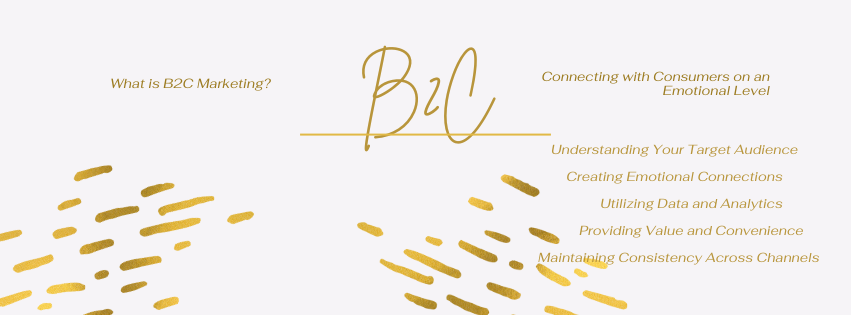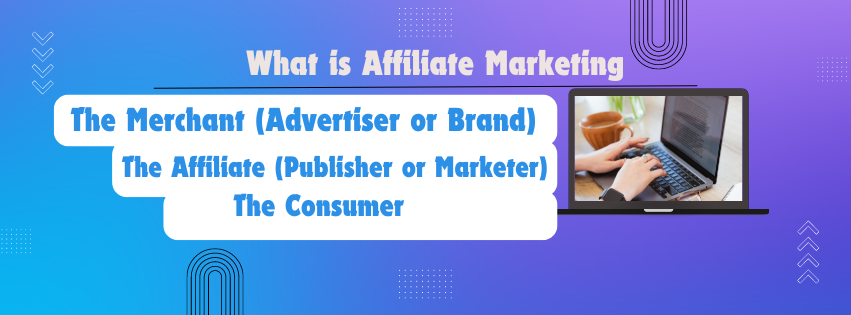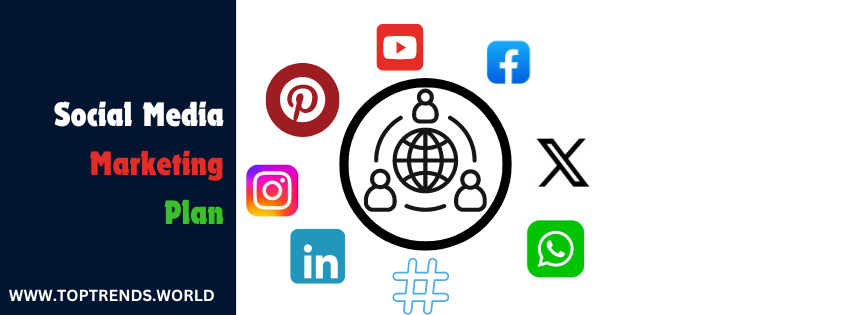B2C marketing (business-to-consumer marketing) focuses on promoting products or services directly to individual consumers.
Unlike B2B (business-to-business) marketing, where the decision-making process is logical and driven by value and ROI, B2C marketing appeals to emotions, desires, and the immediate needs of consumers.
The primary goal of B2C marketing is to generate sales by creating compelling messages and experiences that resonate with consumers on a personal level.
In this blog, we will explore what B2C marketing is, its key strategies, challenges, and how to create successful B2C marketing campaigns.

What is B2C Marketing?
B2C marketing refers to any marketing strategy designed to promote products or services directly to individual customers.
Whether it’s through social media ads, email campaigns, or in-store promotions, B2C marketing seeks to create a strong connection between the brand and the consumer.
B2C marketing often relies on understanding consumer behavior, emotions, and motivations to drive purchase decisions.
The buying process is typically faster than in B2B marketing, with decisions often made on the spot or with minimal research.
Key Differences Between B2C Marketing and B2B Marketing
- Target Audience
- B2C: Targets individual consumers and end-users.
- B2B: Targets businesses, decision-makers, and other professionals.
- Buying Process
- B2C: Shorter sales cycles, often involving impulse decisions and emotional appeal.
- B2B: Longer sales cycles, multiple stakeholders, and decisions based on logic, data, and ROI.
- Relationship Focus
- B2C: Focus on creating quick, one-time sales or short-term customer loyalty.
- B2B: Long-term relationships and ongoing collaboration are crucial.
- Content
- B2C: Content often emphasizes the emotional and personal benefits of a product, with a focus on entertainment, lifestyle, and convenience.
- B2B: Focuses on informative, detailed, and technical content that highlights the benefits, features, and ROI of a product or service.
- Price Points
- B2C: Lower price points and individual purchases.
- B2B: Higher price points, contracts, and recurring transactions.
Key Strategies in B2C Marketing
Social Media Marketing
- Social media platforms like Instagram, Facebook, TikTok, and Twitter are central to B2C marketing. These platforms allow brands to connect with consumers through engaging content, interactive ads, and influencer partnerships. Social media marketing is about building a community around the brand and fostering direct interaction with consumers.
- Example: Fashion brands like Nike use Instagram to showcase their latest collections, engage with followers, and collaborate with influencers to reach a broader audience.
Email Marketing
- Email marketing remains one of the most effective B2C marketing channels for driving sales and customer retention. Personalized emails that offer special promotions, product recommendations, or exclusive discounts can encourage repeat purchases and build brand loyalty.
- Example: E-commerce platforms like Amazon use personalized email campaigns to recommend products based on a customer’s browsing history, encouraging them to complete a purchase.
Content Marketing
- Content marketing in B2C focuses on creating entertaining, informative, or inspiring content that resonates with consumers. Blog posts, videos, infographics, and social media content are all tools to attract and engage potential customers.
- Example: A beauty brand might create tutorials on how to use their products, share customer testimonials, or produce lifestyle content that aligns with their brand values.
Influencer Marketing
- Influencer marketing involves partnering with social media influencers or celebrities who have a strong following and can promote a brand’s products to their audience. Influencers add credibility and reach, making this strategy particularly effective for lifestyle and consumer brands.
- Example: Coca-Cola has collaborated with numerous influencers to promote their beverages through sponsored posts, branded hashtags, and video content that highlights the product in a relatable way.
Paid Advertising
- Paid advertising, including PPC (pay-per-click) ads, social media ads, and display ads, allows brands to reach a wide audience quickly. Targeted ads can be tailored to specific demographics, interests, or behaviors, increasing the chances of conversion.
- Example: A travel agency might run targeted Facebook ads promoting holiday packages to users who have recently searched for travel-related content.
- Loyalty Programs
- Loyalty programs incentivize repeat purchases by offering rewards, discounts, or exclusive access to products. By creating a sense of exclusivity and rewarding customer loyalty, brands can increase customer retention and lifetime value.
- Example: Starbucks offers a loyalty program where customers earn points with each purchase, which can be redeemed for free drinks and food items.
- Search Engine Optimization (SEO)
- SEO is essential for ensuring that a brand’s website appears at the top of search engine results when consumers are looking for relevant products or services. By optimizing content with relevant keywords, improving site speed, and ensuring a mobile-friendly experience, brands can drive organic traffic to their site.
- Example: A home decor company might optimize their website content for keywords like “modern furniture” or “home decor ideas” to attract users searching for those terms.
Mobile Marketing
- With the majority of consumers using mobile devices, mobile marketing is crucial in B2C strategies. This includes mobile-friendly websites, apps, SMS marketing, and location-based services to reach consumers on-the-go.
- Example: Domino’s Pizza offers a mobile app that allows users to place orders, track their delivery, and receive personalized offers, enhancing the customer experience.
Challenges in B2C Marketing
- High Competition
- The consumer market is saturated with brands vying for attention, making it difficult to stand out. B2C marketers must find creative ways to differentiate their brand and capture consumer interest.
- Changing Consumer Behavior
- Consumer preferences and behaviors are constantly evolving, especially with the rise of digital channels. Brands need to stay agile and adapt their strategies to meet changing demands.
- Building Brand Loyalty
- With so many options available, retaining customers and building brand loyalty can be challenging. Brands must consistently deliver value and maintain strong relationships with their customers.
- Balancing Personalization and Privacy
- While personalization is key to effective B2C marketing, it must be balanced with consumer privacy concerns. Brands need to be transparent about data usage and ensure they are complying with regulations like GDPR.
Key Components of a Successful B2C Marketing Campaign
- Understanding Your Target Audience
- A deep understanding of your target audience is essential for creating campaigns that resonate. This includes demographic information, preferences, behaviors, and pain points. Knowing your audience allows for more effective segmentation and personalized messaging.
- Creating Emotional Connections
- B2C marketing is about connecting with consumers on an emotional level. Whether it’s through storytelling, visual content, or brand messaging, tapping into emotions can drive engagement and loyalty.
- Utilizing Data and Analytics
- Data-driven marketing allows brands to track consumer behavior, measure campaign performance, and refine strategies for better results. Tools like Google Analytics, social media insights, and CRM systems provide valuable data to inform decisions.
- Providing Value and Convenience
- Consumers are more likely to engage with brands that offer value and convenience. This could be through high-quality products, exceptional customer service, or easy-to-use online platforms.
- Maintaining Consistency Across Channels
- Consistency in branding, messaging, and customer experience across all channels is crucial for building trust and recognition. Whether consumers interact with your brand online, in-store, or through social media, the experience should be seamless and cohesive.
Examples of Successful B2C Marketing Campaigns
- Apple’s “Shot on iPhone” Campaign
- Apple’s “Shot on iPhone” campaign showcases the impressive capabilities of the iPhone camera through user-generated content. By featuring real photos taken by customers, Apple connects with its audience and highlights the quality of its products in a relatable way.
- Spotify’s Year-End Wrapped Campaign
- Spotify’s “Wrapped” campaign is a yearly personalized summary of a user’s listening habits. It creates a sense of excitement and engagement as users eagerly share their “Wrapped” results on social media, driving brand visibility and user retention.
- Airbnb’s “Belong Anywhere” Campaign
- Airbnb’s “Belong Anywhere” campaign focuses on the emotional aspect of travel, highlighting the idea that staying in an Airbnb allows travelers to feel at home wherever they go. The campaign resonates with the desire for authentic, personalized travel experiences.
- Old Spice’s “The Man Your Man Could Smell Like” Campaign
- Old Spice revamped its brand image with the humorous and memorable “The Man Your Man Could Smell Like” campaign. The ads were a viral hit, leading to a significant increase in sales and brand awareness.
Conclusion
B2C marketing is about understanding consumer behavior, tapping into emotions, and creating experiences that resonate on a personal level. By leveraging strategies like social media marketing, content marketing, and influencer partnerships, brands can connect with their target audience, drive sales, and build long-term loyalty.
The key to successful B2C marketing lies in delivering value, maintaining consistency, and staying attuned to the ever-changing needs and desires of consumers. In a competitive market, those who can create authentic, engaging, and personalized experiences will stand out and thrive.





2 thoughts on “B2C Marketing: Connecting with Consumers on an Emotional Level”